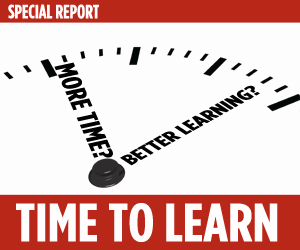New York City’s new mayor, Bill de Blasio, wants to offer after-school programs to all 200,000-plus middle school kids here. To that, you might ask, why middle school? Why not elementary or high?
In an ideal world, of course, every child of every age would have a constructive way to spend the time between class dismissal and dinner, and money would be no object. But this is New York, where de Blasio faces a political fight just to get funding for one age group. Even if the mayor succeeds in getting state lawmakers to approve a tax hike on the rich, propelling his plan into action, he’s banking on a projection that only half of middle schoolers will show up after school. Otherwise, there won’t be enough money. (See Sarah Butrymowicz’s story today for more details.)
Take prioritization as a given, then. At a press conference this month at the Bronx School of Young Leaders, de Blasio offered insight into his logic for prioritizing grades six through eight. It’s simple: As anyone who’s ever been through middle school remembers (and I’ve tried hard to forget), it is an awkward and vulnerable period socially, emotionally and physically –– “a truly challenging transitional moment,” as the mayor called it. Kids need support to emerge unscathed.
Calling himself “a recovering middle school parent,” de Blasio said after-school programs can help students find something they love to do, whether dance, theater or sports, providing motivation that extends to the regular academic day.
“This is exactly the age when a lot of kids are trying to sort out which path to take. It’s our responsibility to give them those good options,” said New York City Mayor Bill de Blasio.
“New York City kids in particular, they grow up fast, and they need positive outlets,” he said, flanked by new Chancellor Carmen Fariña, with whom he said he first connected over a desire to reform middle schools back when he was on the school board in Brooklyn’s District 15 and she was hired as the local superintendent.
“There’s plenty of temptation of the wrong kind around,” de Blasio continued. “There’s plenty of problems around. We’re all aware of that fact. We have to be clear as the adults in the equation that if we don’t want kids going down the wrong path, we have to give them positive options. This is exactly the age when a lot of kids are trying to sort out which path to take. It’s our responsibility to give them those good options.”
Are state legislators willing to put that responsibility on taxpayers earning more than $500,000? The middle school plan has only gotten as far as it has because it’s piggybacking on de Blasio’s higher-profile campaign for universal pre-kindergarten. Let’s face it: Cuddly 4-year-olds are cuter than pubescent 13-year-olds, and an easier public appeal. You don’t see Gov. Andrew Cuomo coming up with a counter-proposal for universal statewide after-school middle school programming as he’s doing on the pre-K front in attempt to avoid a tax hike. (Cuomo has proposed spending $720 million over five years on after-school programs across the state, but not starting until the 2015-2016 academic year, and not with de Blasio’s guarantee of a place for any middle school student who wants one.)
Research is also crystal clear about the benefits of early intervention. By middle school, a child from a poor family has spent an estimated 6,000 fewer hours learning than a child from a rich family –– and half of that gap stems from rich kids having more intellectually stimulating ways to pass the hours after school. And we know it’s easier and far more cost-effective to stop a gap from starting than to close one already wide open.
Related stories
So that’s why after-school programming for elementary kids is important, and advocates hope de Blasio won’t stop with his current plan. But there are ample studies to back the mayor about the importance in middle school, too. (Thanks to The After-School Corporation for compiling this research for me.) Consider:
— A Johns Hopkins study tracking nearly 13,000 urban middle school students over eight years found their sixth-grade attendance, misbehavior and course failures could predict the majority of high school dropouts. But dropout rates improved with efforts to engage the students in middle school and provide them with extra help. More research out of Philadelphia, Baltimore and, yes, New York City had similar findings.
— According to statistics compiled by the Children’s Defense Fund, 31 percent of black boys reported having sex by age 13 –– four times the rate of white boys. Twenty percent reported smoking marijuana by 13, compared with 8 percent of their white peers. If school isn’t engaging children, something else will, and minorities are particularly at risk.
— A report published in the journal American Psychologist found that middle schools often don’t meet young adolescents’ developmental needs to participate in decisions, form relationships with teachers and build independence. After-school programs tend to provide settings more conducive to self-expression.
“The after school grounds them,” de Blasio said. “While they’re going through everything they’re going through in their lives, the after school is a great outlet.”
If the mayor bows to political pressure and accepts Cuomo’s pre-kindergarten offer, his tax hike on the rich would not happen –– and presumably neither would the middle school after-school programs. For now at least, de Blasio is standing firm, making the case for middle schoolers.





